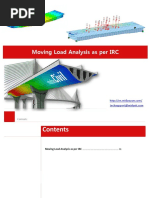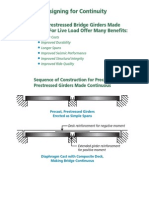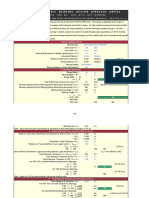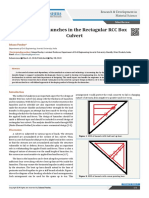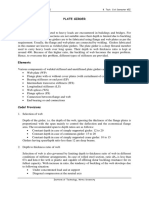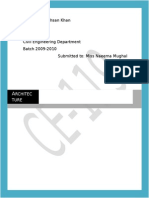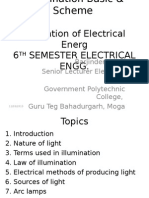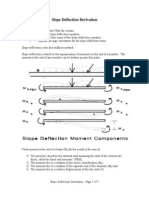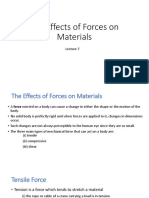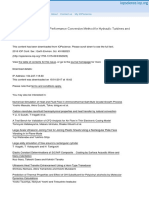End Block Design Aid
Uploaded by
Ahsan KhanEnd Block Design Aid
Uploaded by
Ahsan KhanMeMo to Designers 11-25 october 2012
11-25 Anchorage Zone Design 1
LRFD
11-25 ANCHORAGE ZONE DESIGN
General
The anchorage zone of a post-tensioned concrete box girder member is that area in front of
the prestress blockout where stress concentrations occur. The design engineer is responsible
for the design of both the local zone and the general zone. AASHTO LRFD 5.10.9 covers
the requirements for these regions. In Figure 1, the limits of the anchorage zone are defned
for the purposes of this memo. The equations presented herein are the result of empirically
enveloping three dimensional model results and can be applied to bridges with P
jack
per
girder up to 6000 kips.
Figure 1 - Anchorage Zone limits
Background
General zone design can be accomplished with 3D fnite element modeling. Such models
show that most of the post-tensioning stresses within this region that are of concern to
designers are the vertical tensile stresses and the longitudinal compressive stresses in the
girder webs. Tensile stresses in the top and bottom slabs are relatively small and can be
resisted with typical section transverse reinforcement. Because it is impractical to develop
3D models for every bridge, this memo provides a conservative approach to the design of
the general zone.
Local zone
General zone
h
h
T
d
MeMo to Designers 11-25 october 2012
11-25 Anchorage Zone Design 2
LRFD
Local Zone Design
The size of the local zone and the reinforcement design depend on the anchorage system
used by the post-tensioning Contractor. The Contractor submits the prestress shop drawings
with local zone details to the Design Engineer for review. It is the responsibity of the Design
Engineer to ensure that the local zone details submitted are in agreement with the details
of the preapproved system.
General Zone Design
End Diaphragm Thickness
3D models show that the vertical tensile stresses in the girder webs are reduced with a thicker
diaphragm. Therefore, the minimum recommended diaphragm thickness is as follows:
T
d
> 0.3 x h (1)
In Equation (1) T
d
and h are in feet.
For shallow structures, the absolute minimum diaphragm thickness is 2-6 at abutments
and 2-0 at hinges. Refer to MTD 11-28 for additional diaphragm thickness requirements.
The thickest of these diaphragm requirements shall be used.
Girder Stem Reinforcement
Minimum vertical reinforcement in the girder webs shall be designed as follows:
A
s1
=
2
1.33 *
1200
300*
P
P h
h
| |
|
\ .
Place within the frst
h
/
2
(2)
A
s2
=
2
0.67
1200
300*
P
P h
h
| |
|
\ .
Place within the last
h
/
2
(3)
Where:
A
s1
, A
s2
= Minimum vertical reinforcement to be extended a distance h in front of the
diaphragm. Concentrate
2
/
3
of this reinforcement in the frst h/2 (A
s1
) and
1
/
3
in the latter half (A
s2
). (in.
2
per ft)
h = Cross section depth (ft)
P = P
jack
per girder (kips) (consider the allowable fnal force variation between
girders)
MeMo to Designers 11-25 october 2012
11-25 Anchorage Zone Design 3
LRFD
The designer should frst establish the stirrup schedule for the girders considering all
other loads. The stirrup schedule should then be checked using the equations above. The
requirement for stirrups in the webs within the general zone due to prestressing forces should
not be considered additive to other loads.
Girder Stem Thickness
The webs shall be designed to resist the longitudinal compressive forces. The girder thickness
at the face of diaphragm, t
w
, shall be designed so that:
(t
w
)
REQUIRED
>
( )
*1000
1 *18 3 12 *0.7
1200
d ci
P
P
T f
( | |
+
|
(
\ .
Where:
t
w
= web thickness (in)
T
d
= End diaphragm thickness (in)
= resistance factor for compression = 0.7
f
ci
= specifed concrete strength of the webs at the time of stressing (psi)
Top and Bottom Slab Design
3D fnite element analysis results indicate that the tensile and comprehensive stresses in the
top and bottom slabs are relatively small and therefore resisted by typical section transverse
reinforcement. Standard slab thickness and reinforcement design as indicated by MTD 10-
20 will satisfy General Zone requirements.
Example
Given:
Single span bridge (160 ft) with sloped exterior girders
h = 7-3
P
jack
per girder = 2710 kips
Stirrup design in general zone due to other loads: #5 @ 9
T
d
= 39
f
ci
= 3500 psi
t
w
= 12
skew = 0 degrees
MeMo to Designers 11-25 october 2012
11-25 Anchorage Zone Design 4
LRFD
1) Minimum diaphragm thickness:
a) MTD 11-28 requires 3-3 for sloped exterior girder, no skew, P
j
> 2400 kips/girder
b) 0.3*h = 0.3*7.25 = 2.175 ft
MTD 11-28 controls, use T
d
= 39
2) Vertical stirrup design for general zone bursting stresses, in.
2
/ft
a) #5 @ 9 as designed = 0.31*2*12/9 = 0.83 in.
2
/ft
b) From Eq. (2) in the frst
h
/
2
:
A
s
=
2
2710
1.33 2710* 7.25
1200
300*7.25
| |
|
\ .
= 1.14 in.
2
/ft
c) From Eq. (3) in the last
h
/
2
:
A
s
=
2
2710
0.67 2710 7.25
1200
300 7.25
| |
|
\ .
= 0.57 in.
2
/ft
d) Modify the stirrup schedule as follows:
Stirrups within the frst h/2:
Use #5 @ 6, A
s
= 1.24 in.
2
/ft > 1.14 in.
2
/ft
Stirrups within the second h/2:
Use #5 @ 9, A
s
= 0.83 in.
2
/ft > 0.57 in.
2
/ft, as originally designed
3) Check web thickness for compression
(t
w
)
REQUIRED
=
( )
2710*1000
2710
1 *18 3 39 12 *0.7*0.7*3500
1200
( | |
+
|
(
\ .
= 15.25
(t
w
)
PROVIDED
= 12 < 15.25
MeMo to Designers 11-25 october 2012
11-25 Anchorage Zone Design 5
LRFD
Increase the web thickness for interior girders to 16 at the anchorages and fare to 12 over
16 feet. Exterior girders are typically fared to 18 near the anchorages to make room for the
prestressing trumpets and spiral reinforcement. Therefore, the exterior girders are adequate
as designed for compression.
4) Example details:
39 43.5
#5@6
43.5
#5@9
Longitudinal Section
16-0
16
18
18
12
Girder Layout
MeMo to Designers 11-25 october 2012
11-25 Anchorage Zone Design 6
LRFD
References
Nonlinear Finite Element Analysis of Prestressed Anchorage Zones, Task Order No. 2,
Contract No. 59A0603, Project No. CALT00590202, David Evans and Associates (2011)
Barton J. Newton
State Bridge Engineer
Deputy Division Chief, Structure Policy & Innovation
Division of Engineering Services
Original signed by Barton J. Newton
You might also like
- Academic Guidebook Chemical Engineering Department 2016 2017 EditionNo ratings yetAcademic Guidebook Chemical Engineering Department 2016 2017 Edition181 pages
- Uts-Eng-pro-081 - c2 Air Diving System Lars Operational and Emergency Proc...No ratings yetUts-Eng-pro-081 - c2 Air Diving System Lars Operational and Emergency Proc...21 pages
- High Pressure Turbine Governing System PDF100% (7)High Pressure Turbine Governing System PDF28 pages
- Designing of Flat Plate Corner Panel by DDM100% (2)Designing of Flat Plate Corner Panel by DDM20 pages
- TM 9-768 DIAMOND T 980 AND 981, M9 TRAILER100% (6)TM 9-768 DIAMOND T 980 AND 981, M9 TRAILER446 pages
- ISO 527 Plastic - Determination of Tensile Properties - en100% (1)ISO 527 Plastic - Determination of Tensile Properties - en27 pages
- Comparative Study For The Design of Single Span Bridge Using AASHTO LRFD and Indian Standard MethodNo ratings yetComparative Study For The Design of Single Span Bridge Using AASHTO LRFD and Indian Standard Method5 pages
- Prof Ashok Jain-Example On Torsion - IRC 112 PDFNo ratings yetProf Ashok Jain-Example On Torsion - IRC 112 PDF5 pages
- Free Cantilever Method (Método Del Voladizo Libre)No ratings yetFree Cantilever Method (Método Del Voladizo Libre)48 pages
- Determination of Preliminary Cable Profile in Prestressed Concrete Girders100% (1)Determination of Preliminary Cable Profile in Prestressed Concrete Girders7 pages
- Vol.1 - 34 - How To Input Temperature Gradient Load For A General or PSC SectionNo ratings yetVol.1 - 34 - How To Input Temperature Gradient Load For A General or PSC Section1 page
- The Effects of Differential Shrinkage inNo ratings yetThe Effects of Differential Shrinkage in12 pages
- Design of Bridges: Part - 3: Bridge Design To Irc: 112-2011100% (1)Design of Bridges: Part - 3: Bridge Design To Irc: 112-201133 pages
- Analysis and Design of Prestressed Concrete Box Girder BridgeNo ratings yetAnalysis and Design of Prestressed Concrete Box Girder Bridge18 pages
- Design of Elastomeric Bearing Based On IRC 083-2-1987No ratings yetDesign of Elastomeric Bearing Based On IRC 083-2-19874 pages
- AStrutTie - Design - Example Manual Deep BeamNo ratings yetAStrutTie - Design - Example Manual Deep Beam31 pages
- Dennis Mercado S Structural Engineers BlogNo ratings yetDennis Mercado S Structural Engineers Blog253 pages
- IRC 112 Creep Shrinkage Manual Calculation Vs Midas Civil ValuesNo ratings yetIRC 112 Creep Shrinkage Manual Calculation Vs Midas Civil Values5 pages
- NEW JESRSY - GFRP Crash Barrier Friction SlabNo ratings yetNEW JESRSY - GFRP Crash Barrier Friction Slab9 pages
- Continuous Bridge: By, Vimal A M.Tech (SE)No ratings yetContinuous Bridge: By, Vimal A M.Tech (SE)10 pages
- SERC - Design Tables For Concrete Bridge Deck Slabs TWO WAYNo ratings yetSERC - Design Tables For Concrete Bridge Deck Slabs TWO WAY71 pages
- Ultimate Limit State of Induced Deformation - Sec. 11 of IRC 112 J IRC Vo. 76 - 3No ratings yetUltimate Limit State of Induced Deformation - Sec. 11 of IRC 112 J IRC Vo. 76 - 318 pages
- Summary of AASHTO LRFD Seismic Column DesignNo ratings yetSummary of AASHTO LRFD Seismic Column Design6 pages
- Analysis and Design of Post Tensioned Box Girder Bridge Paper PDFNo ratings yetAnalysis and Design of Post Tensioned Box Girder Bridge Paper PDF8 pages
- Reinforced Concrete Road Bridges: Prof. Nirjhar DhangNo ratings yetReinforced Concrete Road Bridges: Prof. Nirjhar Dhang110 pages
- Bridge Column Design Based On AASHTO 17th & ACI 318-14: Input Data & Design SummaryNo ratings yetBridge Column Design Based On AASHTO 17th & ACI 318-14: Input Data & Design Summary5 pages
- Issues of Vibrations in Footbridges by Mahesh TandonNo ratings yetIssues of Vibrations in Footbridges by Mahesh Tandon17 pages
- St7013 Design of Steel Concrete Composite Structures L T P CNo ratings yetSt7013 Design of Steel Concrete Composite Structures L T P C1 page
- 4x6x2.50 - 4.00m Wide - 0.0mfill - MNB - BOXNo ratings yet4x6x2.50 - 4.00m Wide - 0.0mfill - MNB - BOX63 pages
- Muhammad Ahsan Khan CE-119 SE-Section B Civil Engineering Department Batch 2009-2010 Submitted To: Miss Naeema MughalNo ratings yetMuhammad Ahsan Khan CE-119 SE-Section B Civil Engineering Department Batch 2009-2010 Submitted To: Miss Naeema Mughal6 pages
- Normal Probability Distribution: Natural Sciences Social SciencesNo ratings yetNormal Probability Distribution: Natural Sciences Social Sciences2 pages
- Electrical Functions Start-Up ChecklistNo ratings yetElectrical Functions Start-Up Checklist26 pages
- Applied Thermal Engineering: Unit - 1: Steam GeneratorsNo ratings yetApplied Thermal Engineering: Unit - 1: Steam Generators30 pages
- 3 TRIGON XL 1 CHP 1 Buffer LLH 1 VT Heating Circuit 2 Gemini CalorifiersNo ratings yet3 TRIGON XL 1 CHP 1 Buffer LLH 1 VT Heating Circuit 2 Gemini Calorifiers1 page
- Design of Conventional Foundation-: Engr. Abdul AzizNo ratings yetDesign of Conventional Foundation-: Engr. Abdul Aziz8 pages
- Finite Element Investigation On Plate Buckling Coefficients of Tapered Steel Members Web PlatesNo ratings yetFinite Element Investigation On Plate Buckling Coefficients of Tapered Steel Members Web Plates14 pages
- RP Dynamics Simulator For Motorcycle RapidNo ratings yetRP Dynamics Simulator For Motorcycle Rapid10 pages
- Anti Blast Properties of 6063 T5 Aluminum Alloy Circular Tub - 2021 - Thin WalleNo ratings yetAnti Blast Properties of 6063 T5 Aluminum Alloy Circular Tub - 2021 - Thin Walle19 pages
- New JSME Standard S008 Performance Conversion MethNo ratings yetNew JSME Standard S008 Performance Conversion Meth11 pages
- Real-Time Monitoring of Natural Gas Fuel CleanlinessNo ratings yetReal-Time Monitoring of Natural Gas Fuel Cleanliness5 pages
- Academic Guidebook Chemical Engineering Department 2016 2017 EditionAcademic Guidebook Chemical Engineering Department 2016 2017 Edition
- Uts-Eng-pro-081 - c2 Air Diving System Lars Operational and Emergency Proc...Uts-Eng-pro-081 - c2 Air Diving System Lars Operational and Emergency Proc...
- ISO 527 Plastic - Determination of Tensile Properties - enISO 527 Plastic - Determination of Tensile Properties - en
- Comparative Study For The Design of Single Span Bridge Using AASHTO LRFD and Indian Standard MethodComparative Study For The Design of Single Span Bridge Using AASHTO LRFD and Indian Standard Method
- Free Cantilever Method (Método Del Voladizo Libre)Free Cantilever Method (Método Del Voladizo Libre)
- Determination of Preliminary Cable Profile in Prestressed Concrete GirdersDetermination of Preliminary Cable Profile in Prestressed Concrete Girders
- Vol.1 - 34 - How To Input Temperature Gradient Load For A General or PSC SectionVol.1 - 34 - How To Input Temperature Gradient Load For A General or PSC Section
- Design of Bridges: Part - 3: Bridge Design To Irc: 112-2011Design of Bridges: Part - 3: Bridge Design To Irc: 112-2011
- Analysis and Design of Prestressed Concrete Box Girder BridgeAnalysis and Design of Prestressed Concrete Box Girder Bridge
- Design of Elastomeric Bearing Based On IRC 083-2-1987Design of Elastomeric Bearing Based On IRC 083-2-1987
- IRC 112 Creep Shrinkage Manual Calculation Vs Midas Civil ValuesIRC 112 Creep Shrinkage Manual Calculation Vs Midas Civil Values
- SERC - Design Tables For Concrete Bridge Deck Slabs TWO WAYSERC - Design Tables For Concrete Bridge Deck Slabs TWO WAY
- Ultimate Limit State of Induced Deformation - Sec. 11 of IRC 112 J IRC Vo. 76 - 3Ultimate Limit State of Induced Deformation - Sec. 11 of IRC 112 J IRC Vo. 76 - 3
- Analysis and Design of Post Tensioned Box Girder Bridge Paper PDFAnalysis and Design of Post Tensioned Box Girder Bridge Paper PDF
- Reinforced Concrete Road Bridges: Prof. Nirjhar DhangReinforced Concrete Road Bridges: Prof. Nirjhar Dhang
- Bridge Column Design Based On AASHTO 17th & ACI 318-14: Input Data & Design SummaryBridge Column Design Based On AASHTO 17th & ACI 318-14: Input Data & Design Summary
- Issues of Vibrations in Footbridges by Mahesh TandonIssues of Vibrations in Footbridges by Mahesh Tandon
- St7013 Design of Steel Concrete Composite Structures L T P CSt7013 Design of Steel Concrete Composite Structures L T P C
- Uses of ASME Boiler & Pressure Vessels CodesFrom EverandUses of ASME Boiler & Pressure Vessels Codes
- Muhammad Ahsan Khan CE-119 SE-Section B Civil Engineering Department Batch 2009-2010 Submitted To: Miss Naeema MughalMuhammad Ahsan Khan CE-119 SE-Section B Civil Engineering Department Batch 2009-2010 Submitted To: Miss Naeema Mughal
- Normal Probability Distribution: Natural Sciences Social SciencesNormal Probability Distribution: Natural Sciences Social Sciences
- Applied Thermal Engineering: Unit - 1: Steam GeneratorsApplied Thermal Engineering: Unit - 1: Steam Generators
- 3 TRIGON XL 1 CHP 1 Buffer LLH 1 VT Heating Circuit 2 Gemini Calorifiers3 TRIGON XL 1 CHP 1 Buffer LLH 1 VT Heating Circuit 2 Gemini Calorifiers
- Design of Conventional Foundation-: Engr. Abdul AzizDesign of Conventional Foundation-: Engr. Abdul Aziz
- Finite Element Investigation On Plate Buckling Coefficients of Tapered Steel Members Web PlatesFinite Element Investigation On Plate Buckling Coefficients of Tapered Steel Members Web Plates
- Anti Blast Properties of 6063 T5 Aluminum Alloy Circular Tub - 2021 - Thin WalleAnti Blast Properties of 6063 T5 Aluminum Alloy Circular Tub - 2021 - Thin Walle
- New JSME Standard S008 Performance Conversion MethNew JSME Standard S008 Performance Conversion Meth
- Real-Time Monitoring of Natural Gas Fuel CleanlinessReal-Time Monitoring of Natural Gas Fuel Cleanliness






